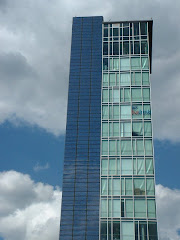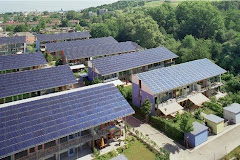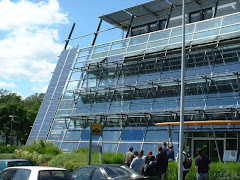Continent's Largest Municipal Utility Proposes Solar Feed-in Tariff
November 30, 2008
By Paul Gipe
Los Angeles Mayor Antonio Villaraigosa announced to much fanfare on November 24 that the city's municipal utility would launch one of the continent's largest solar power programs.
The mayor's plan would direct the city's municipal utility, the Los Angeles Department of Water and Power (LADWP), to build or purchase 1,300 MW of solar energy by 2020.
Among provisions of the plan is a feed-in tariff for 150 MW of solar photovoltaics by 2016. This is the first official announcement of a feed-in tariff proposal by a California city, but it is not the first in the United States.
Gainesville, Florida previously announced that it was formally considering a feed-in tariff to replace its solar rebate program.
Recently, the Palm Springs Desert Sun reported that Palm Desert, California was also considering solar feed-in tariffs after city officials toured Spain, one of the world's leading developers of solar energy. Spain uses feed-in tariffs.
LADWP is the continent's largest municipal utility. It was briefly at the forefront of solar energy development in California from 1999 to 2003, before inexplicably abandoning its program.
The city and LADWP provided no details on the solar feed-in tariff or on the other renewable energy proposals that were part of the mayor's press release. There were no further details on LADWP's web site. Photos of wind turbines on the web site were standard stock photos and all were of wind turbines outside the utility's service area.
LADWP claims that 8.5% of its electricity currently comes from renewables and that the utility is on track to meet its 20% target by 2010. The last report on the utility's web site about its renewable energy program, however, is dated 2003, the year the utility canceled its successful solar program.
Los Angeles' 120 MW Pine Tree wind project is slated to come on line in 2009. The project also is outside of the Los Angeles Basin, just north of the Tehachapi Wind Resource Area.
Interestingly, it was a municipal utility that launched the modern version of Germany's famed feed-in tariffs. Aachen introduced the first solar-specific feed-in tariff in the mid-1990s. Subsequently other German cities followed suit. In 2000 Germany's parliament incorporated the concept behind Aachen's policy in its groundbreaking system of Advanced Renewable Tariffs.
Municipal utilities in the Americas may be able to emulate Aachen and be the first to launch true feed-in tariffs. Because municipal utilities are governed by city officials, they can be more responsive to public demands for action on renewable energy than the often more distant state or provincial legislatures.
Toronto Hydro, North America's second largest and Canada's largest municipal utility, briefly considered a solar PV feed-in tariff in 2007, but took no action. The proposal before Toronto Hydro employed a differentiated feed-in tariff that was intended to work with the province of Ontario's Standard Offer Contract Program.
The proposal of Gainesville Regional Utilities (GRU) is the most advanced in the United States. GRU's commission has ordered preparation of a tariff.
In contrast to Gainesville's approach, LADWP made public little or no information on the details of its proposal. GRU prepared a detailed report which it presented to Gainesville's utility commission when the utility went public with its proposal.
Los Angeles incorporates Hollywood within its city boundaries and there's always an element of showmanship in its pronouncements. The city's proposal is aggressive, more than one-third of the California Solar Initiative's 3,000 MW of solar PV, if it is more than simply aspirational.
The portion of the plan devoted to a feed-in tariff is about one-tenth of the entire program. Countries that have been the most successful at rapidly developing renewable energy (Germany, France, and Spain) use feed-in tariffs as the principal if not only policy mechanism.
Despite the uncritical media accounts of the "world's most ambitious solar plan," attention has focused not only on the targets, but also on the various mechanisms that may be used to reach those targets, including feed-in tariffs.
Regardless of how or even whether it follows through, Los Angeles, as one of North America's largest cities, has put feed-in tariffs, at least for solar, on the continent's public policy map.
Los Angeles Solar Plan Press Release
http://mayor.lacity.org/Issues/Environment/index.htm
The Los Angeles Solar Plan http://mayor.lacity.org/stellent/groups/electedofficials/@myr_ch_contributor/documents/contributor_web_content/lacity_004982.pdf
Palm Desert officials leave on solar trip to Spain: Ferguson and Conlon want to bring feed-in tariff to California (Desert Sun) http://www.windworks.org/FeedLaws/USA/USAList.html
Gainesville Regional Utilities Proposes Solar Feed-in Tariff (Gainesville Sun)
Germany's Success at Transforming Renewable Energy Markets
http://www.wind-works.org/FeedLaws/USA/Ed%20FMEA%20Solar%20Pres%207-8-08.ppt
Gainesville Solar Rate Proposal 10-13-08 Final.doc
http://www.wind-works.org/FeedLaws/USA/Gainesville%20Solar%20Rate%20Proposal%2010-13-08%20Final.doc
The Aachen Solar Tariff Model
http://www.wind-works.org/Solar/TheAachenSolarTariffModel.html
TREC's Proposed Toronto Hydro Solar Initiative
http://www.wind-works.org/Solar/TRECsTorontoHydroProposedSolarInitiative.html
--------------------------------------------------------------------------------
Wednesday, July 8, 2009
Subscribe to:
Post Comments (Atom)




No comments:
Post a Comment